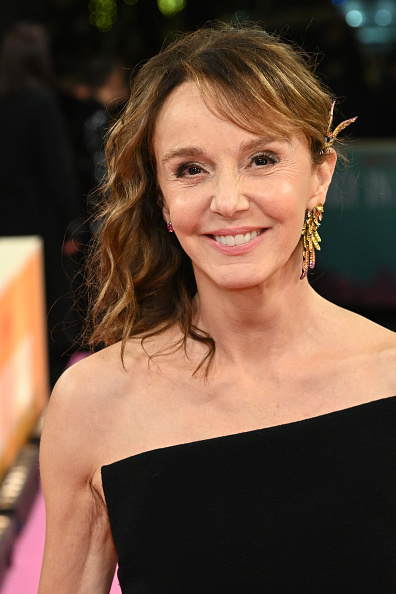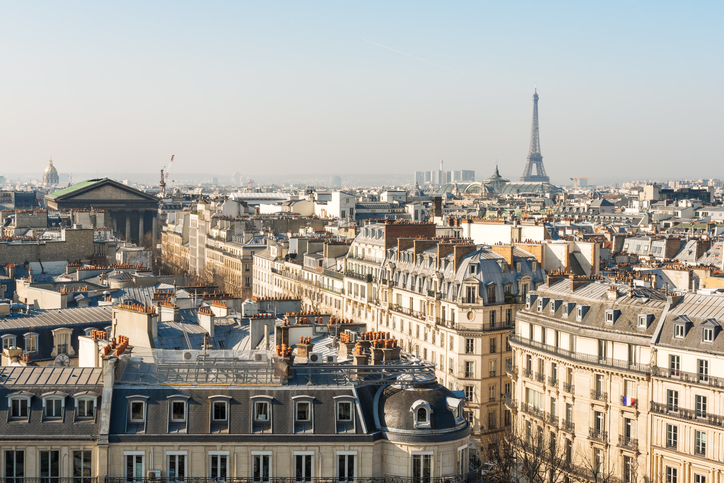‘Emily in Paris’ Star Philippine Leroy-Beaulieu Had a Childhood in Two Acts
The actress on her famous father, growing up in Italy and France, and sharing secrets with her dog
Philippine Leroy-Beaulieu, 59, is a French-Italian actress best known in the U.S. for her role in the French comedy series “Call My Agent!” She appears in season 5 of “The Crown” and currently stars as Sylvie in Netflix’s “Emily in Paris.” She spoke with Marc Myers.
Behind my family’s house in Rome was a garden. It was so large that as a child, I thought of it as a park. For me, that private setting out back in the middle of a city was magical.
The garden was my playground. It had so many different parts. There was a section with pine trees, another like a little acacia forest, and parts with wheat growing. It was a crazy garden but beautiful.
Our house was often filled with many of my parents’ artist friends, so my younger brother, Terence, and I spent a lot of time alone. I’d take my cocker spaniel, Caroline, into the garden and sit under a tree and tell her my secrets. My imagination grew.
My father, Philippe, was a very successful movie actor who made most of his films in Italy. Rome was the center of Europe’s film industry in the late 1960s and ’70s, and he was more popular there than in France.
My mother, Françoise, was initially an interior decorator, but she later designed jewelry, knitwear and accessories for Dior, where she worked for 20 years.
As a child, I thought of myself as Italian. In Rome, I was exposed to so much visual beauty that I wondered why other places weren’t as special. Italians were warm and teased me in a sweet way. I’d laugh a lot.
When I was 7, we visited my father on a set. He was in “The Life of Leonardo da Vinci,” a popular Italian miniseries in 1971. After makeup, he looked just like Leonardo in his self-portrait. I was stunned.
Because my father had a strong French accent, his voice in films was overdubbed. So when I saw the miniseries, he not only looked different but he sounded different. I’d have nightmares of my father speaking to me in strange voices.
Watching my father on set made me curious about being someone else. I came to realize that adults play at make-believe, not just children, and that playacting was a way for me to become an adult.
Then my parents divorced when I was 10½. Their separation was hard on me. My mother took Terence and me to live with her in Paris. She started working at Dior when I was 13.
The hardest part about leaving Rome was the loss of my country and identity. I had to rebuild the whole thing. In school, I wasn’t accepted as French. I didn’t speak the language perfectly and I didn’t have the same cultural references as other children. The kids were mean and called me terrible things. They often left me out. It was hard, but the experience made me the person I am, so it’s fine.
As a teenager, I began to sing in front of the mirror in my room. I’d sing songs from “Cabaret” and “Jesus Christ Superstar.” At 13, I decided I was going to be an actor. I told my mother, but she was totally against it. The subtext was, “You’re not going to be like your dad.” I decided that as soon as I finished school, I’d do whatever I wanted.
After high school, I spent a year at the Sorbonne, studying French literature. While there, I had an Italian literature teacher who was fond of Italian drama. When he announced he was planning to stage Carlo Goldoni’s “La Locandiera,” I said I was in.
I was cast in the play. I took acting lessons and helped make costumes. We performed at the Italian Cultural Center in Paris. It felt very natural to be on stage.
When I was 19, I was cast in Roger Vadim’s French comedy, “Surprise Party.” Then came Judith Krantz’s “Mistral’s Daughter” and a TV miniseries in the U.S. In 1985, I had a major role in “Three Men and a Baby” in France, which was a huge hit. That launched my career.
My big break in America came during the pandemic. With the lockdown, people spent more time streaming series and saw me in “Call My Agent!” “Emily in Paris” came next.
Today, I live in an apartment in Paris’s Saint-Germain section on the Left Bank, where my parents first met. I moved in five years ago. The silence and calm make my home so peaceful.
I also have a beautiful view of the back of a neo-Gothic church. When Sunday Mass is held, I can hear singing and smell the incense if the wind is just right.
When I’m not shooting a TV series or a film, I love visiting the Fontainebleau forest, about a half-hour south of Paris. I can spend hours there walking the pathways and never run into anyone. It’s like my garden in Rome, only bigger.
Philippine’s Flips
Your role in “Emily in Paris”? They originally wanted someone 35 to 45 years old for Sylvie. I auditioned, but I didn’t hear back for months.
Why? They loved me for the part, but they first had to revise the script to make Sylvie a character who freely judges everyone.
Mom? She passed in early 2020. I treasure a brooch she designed and gave me. It’s a crescent moon with green and red stones and pendants hanging down.
Dad? I travel to Rome often to see him. He’s calmer, sweeter and softer now and very proud of what’s happening with my career.
 Copyright 2020, Dow Jones & Company, Inc. All Rights Reserved Worldwide. LEARN MORE
Copyright 2020, Dow Jones & Company, Inc. All Rights Reserved Worldwide. LEARN MORE
This stylish family home combines a classic palette and finishes with a flexible floorplan
Just 55 minutes from Sydney, make this your creative getaway located in the majestic Hawkesbury region.
As Paris makes its final preparations for the Olympic games, its residents are busy with their own—packing their suitcases, confirming their reservations, and getting out of town.
Worried about the hordes of crowds and overall chaos the Olympics could bring, Parisians are fleeing the city in droves and inundating resort cities around the country. Hotels and holiday rentals in some of France’s most popular vacation destinations—from the French Riviera in the south to the beaches of Normandy in the north—say they are expecting massive crowds this year in advance of the Olympics. The games will run from July 26-Aug. 1.
“It’s already a major holiday season for us, and beyond that, we have the Olympics,” says Stéphane Personeni, general manager of the Lily of the Valley hotel in Saint Tropez. “People began booking early this year.”
Personeni’s hotel typically has no issues filling its rooms each summer—by May of each year, the luxury hotel typically finds itself completely booked out for the months of July and August. But this year, the 53-room hotel began filling up for summer reservations in February.
“We told our regular guests that everything—hotels, apartments, villas—are going to be hard to find this summer,” Personeni says. His neighbours around Saint Tropez say they’re similarly booked up.
As of March, the online marketplace Gens de Confiance (“Trusted People”), saw a 50% increase in reservations from Parisians seeking vacation rentals outside the capital during the Olympics.
Already, August is a popular vacation time for the French. With a minimum of five weeks of vacation mandated by law, many decide to take the entire month off, renting out villas in beachside destinations for longer periods.
But beyond the typical August travel, the Olympics are having a real impact, says Bertille Marchal, a spokesperson for Gens de Confiance.
“We’ve seen nearly three times more reservations for the dates of the Olympics than the following two weeks,” Marchal says. “The increase is definitely linked to the Olympic Games.”

Getty Images
According to the site, the most sought-out vacation destinations are Morbihan and Loire-Atlantique, a seaside region in the northwest; le Var, a coastal area within the southeast of France along the Côte d’Azur; and the island of Corsica in the Mediterranean.
Meanwhile, the Olympics haven’t necessarily been a boon to foreign tourism in the country. Many tourists who might have otherwise come to France are avoiding it this year in favour of other European capitals. In Paris, demand for stays at high-end hotels has collapsed, with bookings down 50% in July compared to last year, according to UMIH Prestige, which represents hotels charging at least €800 ($865) a night for rooms.
Earlier this year, high-end restaurants and concierges said the Olympics might even be an opportunity to score a hard-get-seat at the city’s fine dining.
In the Occitanie region in southwest France, the overall number of reservations this summer hasn’t changed much from last year, says Vincent Gare, president of the regional tourism committee there.
“But looking further at the numbers, we do see an increase in the clientele coming from the Paris region,” Gare told Le Figaro, noting that the increase in reservations has fallen directly on the dates of the Olympic games.
Michel Barré, a retiree living in Paris’s Le Marais neighbourhood, is one of those opting for the beach rather than the opening ceremony. In January, he booked a stay in Normandy for two weeks.
“Even though it’s a major European capital, Paris is still a small city—it’s a massive effort to host all of these events,” Barré says. “The Olympics are going to be a mess.”
More than anything, he just wants some calm after an event-filled summer in Paris, which just before the Olympics experienced the drama of a snap election called by Macron.
“It’s been a hectic summer here,” he says.

AFP via Getty Images
Parisians—Barré included—feel that the city, by over-catering to its tourists, is driving out many residents.
Parts of the Seine—usually one of the most popular summertime hangout spots —have been closed off for weeks as the city installs bleachers and Olympics signage. In certain neighbourhoods, residents will need to scan a QR code with police to access their own apartments. And from the Olympics to Sept. 8, Paris is nearly doubling the price of transit tickets from €2.15 to €4 per ride.
The city’s clear willingness to capitalise on its tourists has motivated some residents to do the same. In March, the number of active Airbnb listings in Paris reached an all-time high as hosts rushed to list their apartments. Listings grew 40% from the same time last year, according to the company.
With their regular clients taking off, Parisian restaurants and merchants are complaining that business is down.
“Are there any Parisians left in Paris?” Alaine Fontaine, president of the restaurant industry association, told the radio station Franceinfo on Sunday. “For the last three weeks, there haven’t been any here.”
Still, for all the talk of those leaving, there are plenty who have decided to stick around.
Jay Swanson, an American expat and YouTuber, can’t imagine leaving during the Olympics—he secured his tickets to see ping pong and volleyball last year. He’s also less concerned about the crowds and road closures than others, having just put together a series of videos explaining how to navigate Paris during the games.
“It’s been 100 years since the Games came to Paris; when else will we get a chance to host the world like this?” Swanson says. “So many Parisians are leaving and tourism is down, so not only will it be quiet but the only people left will be here for a party.”
This stylish family home combines a classic palette and finishes with a flexible floorplan
Just 55 minutes from Sydney, make this your creative getaway located in the majestic Hawkesbury region.






















